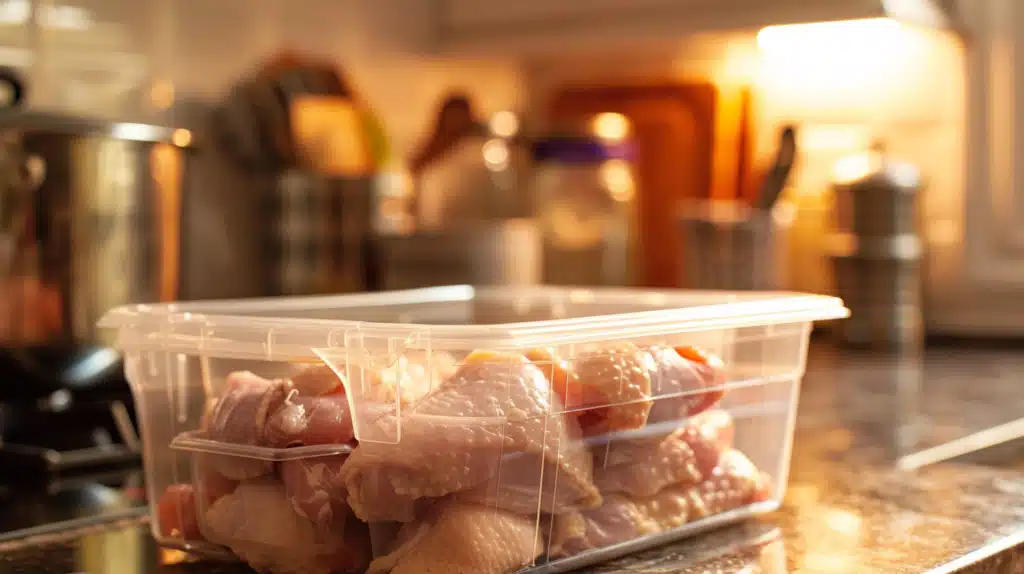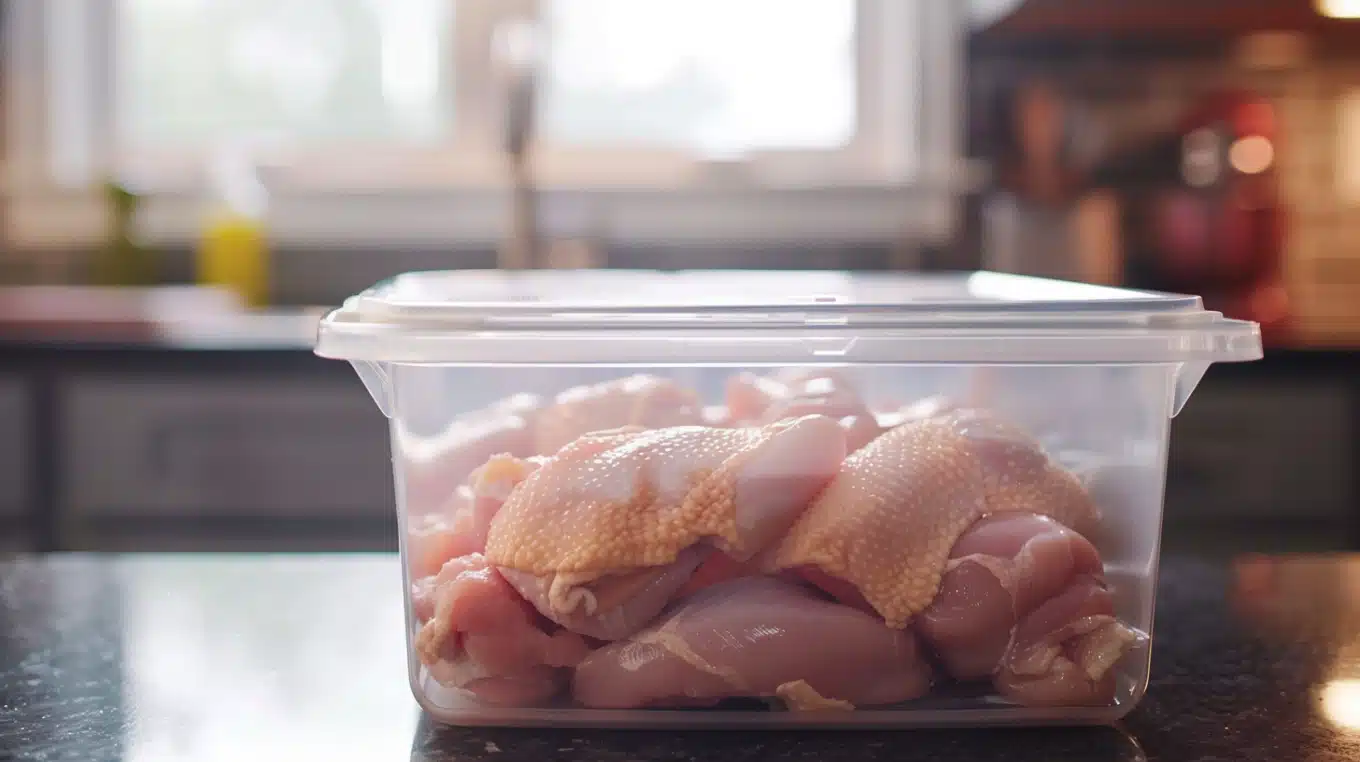Storing chicken properly is essential for maintaining its quality and preventing bacterial growth.
However, many people struggle with keeping their chicken fresh, often finding it spoiled or emitting unpleasant odors.
By following some simple guidelines, you can master the art of chicken storage and say goodbye to foul smells in your fridge.
In this post, we’ll cover the fundamentals of proper chicken storage, including the ideal temperature and duration for raw and cooked chicken and tips for preventing cross-contamination.
We’ll also discuss identifying spoiled chicken and what to do with leftovers. By the end, you’ll have the knowledge and confidence to store your chicken like a pro.
Understanding Chicken Shelf Life

Properly storing chicken is key to keeping it fresh and safe to eat.
Let’s examine the shelf life of both raw and cooked chicken and learn how to identify signs of spoilage.
1. Raw Chicken
Raw chicken should be stored in the fridge for only 1-2 days to maintain its freshness and prevent bacterial growth.
If you need to keep it longer, freezing is your best bet.
Chicken pieces can be frozen for up to 9 months, while a whole chicken can last up to 1 year in the freezer.
To ensure optimal freshness, your fridge should be at or below 40°F (4°C) to slow bacterial growth.
Use airtight containers or freezer-safe bags to prevent freezer burn and contamination when storing chicken.
If preparing chicken for the freezer, wrap it tightly in plastic wrap before placing it in a freezer bag, removing as much air as possible to maintain quality.
2. Cooked Chicken
Cooked chicken can be stored in the fridge for 3-4 days, keeping it safe to eat within this timeframe.
If you need to store it longer, cooked chicken can be frozen for up to 4 months.
Just like with raw chicken, ensure your fridge is at or below 40°F (4°C) and your freezer at 0°F (-18°C) for optimal preservation.
Store cooked chicken in airtight containers to prevent moisture loss and contamination.
When reheating, the chicken should reach an internal temperature of 165°F (74°C) to kill any potential bacteria.
3. Spoiled Chicken Indicators
Knowing how to identify spoiled chicken is crucial to avoid foodborne illnesses.
A rotten or sour odor indicates that chicken has gone bad and should not be consumed.
If the chicken feels slimy or sticky, it indicates bacterial growth and should be discarded.
Additionally, if the chicken has a grayish or greenish hue, it is no longer fresh and unsafe to eat.
Regularly inspect your chicken for these signs before cooking or eating.
Always thoroughly wash your hands and surfaces after handling spoiled chicken to prevent cross-contamination.
To minimize the risk of spoilage, monitor dates closely and practice the FIFO (First In, First Out) method, ensuring older chicken is used first.
4 Common Techniques to Store Chicken to Prevent Foul Smell

Storing chicken properly is essential to maintain its quality and prevent bacterial growth.
From refrigeration to freezing and thawing, here are the best practices for keeping your chicken fresh and safe.
1. Refrigeration
When storing raw chicken in the fridge, place it in the coldest part, ideally on the bottom shelf.
This minimizes the risk of cross-contamination from dripping juices.
Always use airtight containers to keep the chicken fresh and prevent exposure to air and bacteria.
Ensure your fridge maintains a temperature of 40°F (4°C) or lower, and remember that raw chicken should be used within 1-2 days when refrigerated.
To keep track of freshness, label the containers with the storage date.
2. Freezing
To freeze chicken properly, wrap it tightly in plastic wrap or place it in airtight containers or freezer-safe bags to prevent freezer burn.
Remove as much air as possible from the packaging to extend the chicken’s shelf life.
Set your freezer to 0°F (-18°C) to freeze the chicken properly.
Consider dividing the chicken into meal-sized portions before freezing for convenience.
Don’t forget to label the packages with the date to track storage duration and use within recommended time frames.
3. Thawing Methods
- Refrigerator Method: The safest way to thaw frozen chicken is to place it in the fridge and allow it to thaw slowly. Although this method takes the longest, it ensures even thawing and prevents bacterial growth.
- Cold Water Method: For a faster option, submerge the chicken in its airtight packaging in cold water, changing the water every 30 minutes. This method requires more attention but is still safe.
- Microwave Method: You can use the microwave’s defrost setting to thaw the chicken. However, cook the chicken immediately after thawing to ensure safety and prevent bacterial growth.
Never thaw chicken at room temperature, leading to bacterial growth and foodborne illnesses.
When cooking thawed chicken, ensure it reaches an internal temperature of 165°F (74°C) to guarantee it is safe to eat.
4. Using Airtight Containers
Airtight containers are essential for maintaining the freshness of both raw and cooked chicken.
They prevent exposure to air, which can cause the chicken to dry out and lose its quality, and protect it from contaminants and bacteria.
When using airtight containers, ensure they are properly sealed to maximize their effectiveness.
Opt for containers made of durable, food-grade materials like glass or BPA-free plastic, as they are less likely to harbor bacteria and are easy to clean.
For raw chicken, place it in an airtight container immediately after purchase or preparation to keep it fresh until cooking.
After cooking, allow the chicken to cool slightly before transferring it to an airtight container to prevent condensation, which can lead to spoilage.
Label the containers with the storage date to track how long the chicken has been stored, and use it within safe time limits.
Preventing Cross-Contamination

Cross-contamination is a serious concern when handling raw chicken.
Prevent the spread of harmful bacteria by following these simple yet essential tips for separation and hygiene.
1. Separation
Always keep raw chicken separate from other foods in the fridge to prevent raw juices contaminating ready-to-eat items like fruits and vegetables.
- Use separate cutting boards and utensils for raw chicken to avoid cross-contamination during food preparation.
- Store raw chicken on the fridge’s bottom shelf to ensure any drips don’t reach other foods.
- Consider using color-coded cutting boards (e.g., red for meat) to make it easy to remember which board to use for which type of food.
- To further minimize the risk of cross-contamination, designate specific areas in your kitchen for handling raw chicken, keeping it isolated from other food prep areas.
2. Hygiene
Proper hygiene is crucial when handling raw chicken.
- Wash your hands thoroughly with soap and water for at least 20 seconds after handling raw chicken to prevent the spread of bacteria to other foods, surfaces, or utensils.
- Clean all surfaces and utensils that have come into contact with raw chicken using hot, soapy water, including countertops, cutting boards, knives, and other tools.
- For extra safety, sanitize surfaces with 1 tablespoon of unscented liquid chlorine bleach solution in 1 gallon of water.
- Use a dishwasher to clean utensils and cutting boards, as the high temperature helps kill bacteria.
- Consider using disposable gloves when handling raw chicken and discarding them immediately after use to reduce the risk of contamination.
By implementing these separation and hygiene practices, you can significantly reduce the risk of cross-contamination and keep your kitchen safe when handling raw chicken.
Best Practices for Handling Chicken
From the moment you bring chicken home to storing leftovers, proper handling is essential for maintaining quality and safety.
Here are some best practices to keep in mind.
1. Initial Storage
As soon as you get home from the store, place your chicken in the fridge or freezer to maintain its freshness and prevent bacterial growth.
If you use the chicken within a day or two, store it in its original packaging.
For longer storage, repackage the chicken in airtight containers or freezer-safe bags to prevent exposure to air and contamination.
To provide optimal storage conditions, ensure your fridge is set to 40°F (4°C) or lower and your freezer to 0°F (-18°C).
To help track freshness and prioritize older items, label the packages with the date of purchase.
2. Leftovers Management
When storing cooked chicken leftovers, use airtight containers to maintain moisture and prevent contamination.
Consume leftovers within 3-4 days for optimal safety and quality.
To ensure any remaining bacteria are killed, reheat leftovers to an internal temperature of 165°F (74°C).
Use a food thermometer to check the temperature accurately.
To make reheating easier and reduce waste, divide leftovers into meal-sized portions before storing them.
3. Rotisserie and Fried Chicken
Rotisserie chicken can be stored in the fridge for up to 4 days. You can freeze it for up to 2 months if you need it longer.
Similarly, store fried chicken in airtight containers and consume it within 4 days to maintain its texture and flavor.
When freezing rotisserie or fried chicken, wrap it tightly in plastic wrap or foil before placing it in a freezer bag or airtight container.
Don’t forget to label the package with the date to track storage time.
By following these best practices for handling chicken, you can ensure that your meals are not only delicious but also safe to eat.
Conclusion
Mastering chicken storage is essential for maintaining your meals’ quality, freshness, and safety.
By knowing the shelf life, using proper storage methods, avoiding cross-contamination, and following handling tips, you can safely store and enjoy chicken without worrying about foodborne illnesses or bad smells.
Remember, the key to success lies in the details – from the temperature of your fridge to how you package your chicken for freezing.
By taking these steps and staying vigilant, you’ll be able to say goodbye to foul smells and hello to delicious, safe meals every time.
So, what’s next? Put these tips into practice and take control of your chicken storage game.
Your taste buds and your nose will thank you!
Frequently Asked Questions
Can I Store Raw Chicken in A Ziploc Bag?
Yes, you can store raw chicken in a Ziploc bag. Make sure to remove excess air before sealing and place it in the coldest part of the fridge.
How to Store Chicken for A Long Time?
To store chicken for a long time, place it in an airtight container or freezer bag and freeze it. It can last up to 9-12 months.
How to Tell if Raw Chicken is Bad?
You can tell if raw chicken is bad by its smell (rotten or sour odor), texture (slimy or sticky), and color (grayish or greenish hue).
How Long Does Raw Chicken Last in A Ziplock Bag?
Raw chicken can last 1-2 days in a ziplock bag when stored in the refrigerator. For longer storage, freeze it, and it will last up to 9 months.




